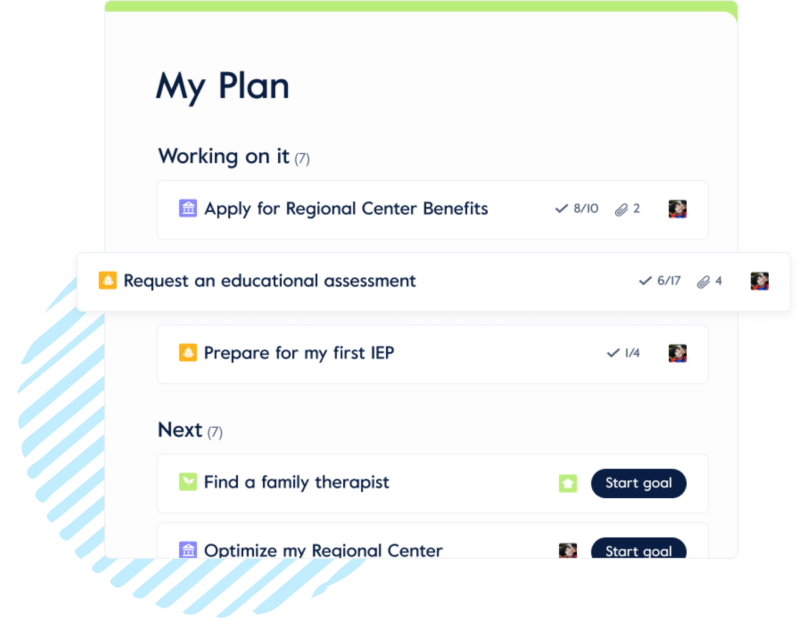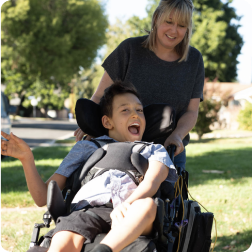Autism Roadmap

From birth to age 3, it’s important to secure early intervention services for children who have a suspected developmental disability or delay. Statewide public benefits programs such as Regional Center can be a source of assessment services and therapies regardless of family income. Getting started early with public related benefits can significantly streamline access to key services.
At age 3, a child’s school district becomes primarily responsible for providing therapeutic services for individuals who qualify for an Individualized Education Program (IEP). The process starts as early as preschool. For eligible children, public benefits programs can supplement insurance funding for medical services, therapies, and equipment.
The transition to elementary school is a big step. Parents should work closely with their IEP teams from year to year to develop IEPs that provide the accommodations, services, and other supports necessary for their children to thrive.
Transitioning to middle school and then high school involves different supports to help children with disabilities continue developing their academic, social, and functional life skills. These supports can be provided by the school district, insurance, and public benefits programs. Some programs have different evaluation criteria in the teen years for how much support a child needs compared to their typically developing peers, so it’s possible to get respite or supervision hours increased.
Although planning for the transition to adulthood can begin as early as eighth grade, age 16 is when many government programs officially provide support. Parents should work with their IEP teams and their child to develop an Individual Transition Plan (ITP) that considers future education, work, and living arrangements. This is the time for parents to plan for their child becoming a legal adult at age 18.
Many students with an IEP have up to age 22 to obtain a high school diploma, during which time they may also participate in adult transition programs from the school district or Regional Center. Many government benefits programs have different eligibility criteria for minors than for individuals 18 and above, so young adults can see if they qualify for public medical insurance, food assistance, Social Security, and more.
Priorities by Age
Overwhelmed? We get it.
If you live in California, we can help you customize your child’s roadmap, no matter where you are in the journey.
We know how to help families raising kids with disabilities and learning differences because our team has been there: We wrestled with uncertainty and fear over new diagnoses. We felt overwhelmed and isolated going down internet rabbit holes in search of information. We felt the stress of caregiving, the pressure of not enough hours, the professional and financial loss of needing to leave a job in order to try to tackle navigating benefits, services, insurance, and more.
The good news? We used all of this collective experience as fuel to build a team of experts to bring families support, solutions, and relief.
Introducing: the Undivided platform
Our innovative software helps you develop a custom roadmap for your child’s care—including goals, documents and notes, step-by-step guides, and resources—tailored to your family’s unique needs.

What is a Navigator?
Lifeline. Lifesaver. Mentor. Friend. Safe space. These are just some of the ways families describe our Navigators.
Our Navigators are parents who leverage their own personal experience, as well as insights from working with thousands of other families navigating similar paths to care for their children. Each dedicated Navigator is supported by a team of researchers, advocacy experts, and public benefits specialists who all thrive on finding solutions and opportunities for Undivided families.
To experience this kind of 1:1 support for yourself, sign up for a Kickstart, a free 10-day period in which you’ll be paired with a dedicated Navigator who will work with you over two Zoom sessions and unlimited messaging. After your free Kickstart period, you can pursue your customized roadmap on your own or sign up for a paid membership that provides access to all the digital tools of the Undivided platform plus the guidance of your Navigator to help you find your wins faster than you could do alone.
Related Resources
If you’re looking for additional resources, we have you covered. Our editorial and research teams work with interdisciplinary experts to bring our community a wealth of science-backed information and compassionate advice.
Here are some key resources related to supporting kids with autism.














